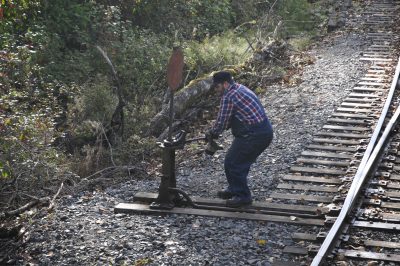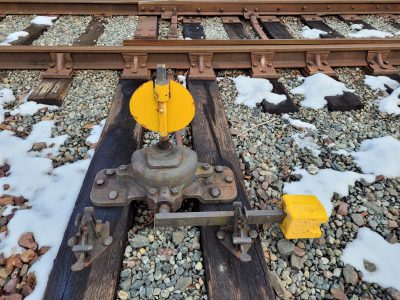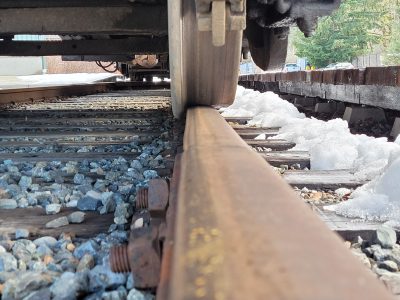Visitors frequently ask how objects on the track work. If Museum staff are around, you are welcome to ask, and most will be able to give an explanation or demonstration. The Museum sees a lot of guests try to figure these things out on their own, which is not recommended, as the Museum railway is active. Switches are the object most guests gravitate towards.
There are two types of switches at the NRM, the main line switches and the yard switches:

Michael H. throwing one of the main line switches.
The main line switches are tall with a red circle atop and a lever that moves the points of the rail when pulled. Guests will not be able to move these switches as standard practice is to lock main line switches after use. A train with passengers is never allowed to cross an unlocked main line switch.

One of the Museum’s yard switches with the rail points in the background.
The yard switches are closer to the ground and easier to throw quickly during railway switching operations. These have a latch and a heavy lever that is “thrown” in an arc and then stomped down to make sure it is fully latched.
Railway rules require train crew to wear gloves and steel-toed boots. If the switchman is not careful, the switch can drop on a toe or a hand caught in the lever. When a visitor plays with a switch, it can impact regular switching operations because the rail is now aligned to a different track. It goes to show, it is better to look, not touch.

A closer look at one of the wheels on Coach 276.
Why does this matter? If you have ever looked closely at railway equipment wheels, the flange that rolls along the inside of the rail is a lot thinner than the rest of the wheel. A small gap could catch the wheel flange and send the equipment off course. It only takes a small gap around a switch to damage equipment or derail a train.
For the safety of yourselves and our volunteers when visiting the Museum, please do not play on the tracks or move things around. It is easy to get hurt without proper training, and no one wants to be the cause of an accident.

